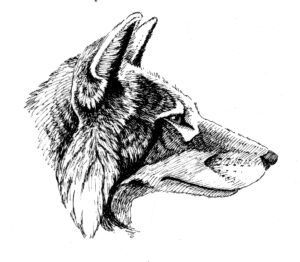Wolves in a Test Tube

BY Matt Dunlap
Sometimes, truth is stranger than fiction. In 1993, the blockbuster science fiction film Jurassic Park had a plotline that a group of paleo-geneticists had extracted dinosaur DNA from fossils, and had been able to create a new generation of velociraptors and other large herbivorous and carnivorous dinosaurs. When, in the movie, everything goes wrong and the dinosaurs get loose, the cast must use their wits to survive.
Gene Roddenberry, creator of the Star Trek television series and movie franchise, once remarked that the toughest thing they had to do was to stay three hundred years ahead of the growing technological boom of the 1960s. Now, just thirty-two years after Jurassic Park, comes the news that a company called Colossal Biosciences has used genetic technology to create not pterodactyls, but to resurrect an extinct species of wolf that wrought terror in North America during the Pleistocene Epoch, a period of time from just over 11 million years back to about 11,000 years ago. Geologically, it was the last great period of glaciation.
Dire Wolf
The Dire wolf was a true apex predator. Much larger than the grey wolves that are (in many sections of the country, including Maine) so controversial for their impact as predators, the prey species the Dire wolf depended on included wooly mammoths, giant ground sloths, and mastodons—broadly categorized as megafauna. With the changing climate and the gradual disappearance of megafauna, due at least in part to competition from a growing human population, Dire wolf populations dwindled and eventually disappeared some 13,000 years ago.
There’s a lot to ponder here. We know from cave drawings that our forebears had to contend with much different animals than we can hunt for in Maine. Along with cave bears, which were larger than grizzlies or brown bears (but which were vegetarian), Europe was home to aurochs (giant cattle), wooly rhinos, bison, and a long-extinct species of lion where the males did not have the manes of the African lions today. Some years back, a walrus tusk was found on the banks of Marsh Island in the Penobscot River, which this column space is the namesake for, indicating that as the glacial melt created torrents of water that formed the Penobscot Valley that the island was home to a walrus colony.
Is there value in resurrecting vanished species? The process of de-extinction has curious scientific, moral, and not least of all, management implications. Colossal Biosciences strung samples of recovered Dire wolf DNA together and used grey wolf embryos embedded with the Dire wolf DNA and implanted them in dogs to reproduce the long-disappeared Dire wolf pups.
Video of the pups howling a wolf song not heard for thirteen thousand years is haunting, to be sure. Questions, though, remain—can our ecosystem sustain new apex predators? Can they survive and thrive in a climate much different than the end of the last Ice Age? There is also talk about using this technology to bring back wooly mammoths, dodo birds and aurochs. The same questions lurk over those discussions. What are the implications for the fauna that survived the last epoch, like grey wolves, moose, elk, mountain lions, deer, musk ox, and many other species that already face tremendous pressures from encroaching development and an ever-changing climate?
Population Seeding
Proponents of this work point to the opportunity to shore up wildlife species whose populations are at risk, which is an excellent point; the idea of more broadly “seeding” a population that faces downward pressure in order to boost numbers feels a lot better than trying to capture those last remaining specimens for safekeeping in zoos.
Over the last few decades, the re-introduction of gray wolves to the northeast United States is a proposal that has boiled in controversy. Farmers and sportsmen have worried openly about the impact of the return of wolves to an ecosystem that hasn’t seen such a predator in over 140 years, and those concerns were strong enough to mandate a registration system for wolf-dog hybrids that included ear tags and dental gum tattoos for identification if they escaped or were turned loose in the wild. What if we skipped right over gray wolves and wolf hybrids and found Dire wolves in northern Maine?
After the public introduction of the two male and one female Dire wolf pups, named Romulus, Remus and Khaleesi, Colossal Biosciences said that the pups were being kept in a 2,000 acre facility “somewhere” in the northern United States, and that the new population of Dire wolves would remain in captivity.
Until, like in the movie, it all goes wrong. Stay tuned.
For more articles about hunting, fishing and the great outdoors be sure to subscribe to the .
